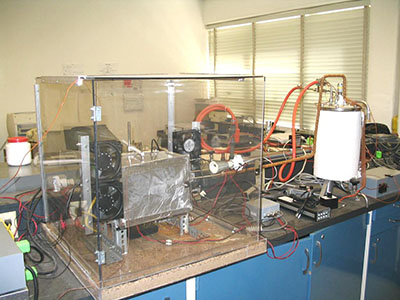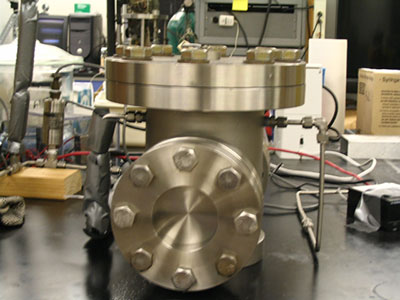Relative Humidity Facility for Plasticizer Jump Experiment
Relative humidity (RH) jump experiments are performed using a custom built RH chamber. This is a double-layered polycarbonate box. Temperature and relative humidity are controlled independently. Temperature is controlled using an Omega temperature controller. Relative humidity is controlled using a PID program. One stream of dry cold air is directed to the system at constant flow rate. A second air stream, regulated by a solenoid valve passes through a steam generator before entering the environmental chamber. The degree of valve opening is regulated by an analog signal from the RH feedback loop. The dry and wet air streams are mixed by tube fans in the chamber.

Pressure Vessel
The pressure vessel was designed and built at the National Institute of Standards and Technology for measuring the swelling of elastomers and modified for the creep compliance measurement under carbon dioxide pressure. The system was further modified in our laboratory. The pressure vessel is made of type 304 stainless steel and designed for a maximum working pressure of 8 MPa with two view ports 180° apart for viewing and backlighting purposes. The cylindrical vessel has 2.25 L of inner volume.
To maintain a constant temperature, the pressure vessel is placed in a rectangular bath and completely immersed in silicone bath oil (clear type Rhodorsil 47 V 20). For insulation, an aluminum thin film is placed over a 50-mm-thick fiberglass sheet that is wrapped around the circumference of the bath. Two circular glass windows are incorporated into the oil bath so that the view ports of the pressure vessel are visible.

The bath is heated with a 750 W Fisher immersion heater and stirred to maintain temperature uniformity using a 49 W Cole-Parmer Stir-Pak mixer. The temperature of the silicone oil bath is controlled by an Omega controller-type CNi 1622. The temperature, measured inside the vessel close to the sample, is stable to within ±1 °C as measured by a type-K thermocouple with a resolution of ± 0.1 °C. The pressure vessel is evacuated for 30 min at 60 °C with a vacuum pump, and then the carbon dioxide is delivered to the system from a CO2 cylinder with a maximum PCO2 of ≈ 5.6 MPa. The CO2 pressure is monitored with a pressure transducer with an absolute pressure range of 0-10.5 MPa and controlled by two Omega electro valves type SV128 and held stable within 0.05 MPa.
Experimental Application
Related Publications
- Y. Zheng, G. B. McKenna, "Structural Recovery in a Model Epoxy: Comparison of Responses after Temperature and Relative Humidity Jumps" Macromolecules 36 (7): 2387-2396, 2003.
- Y. Zheng, R. D. Priestley and G. B. McKenna, "Physical Aging of an Epoxy Subsequent to Relative Humidity Jumps through the Glass Concentration", J. Polym. Sci., B. Polym.Phys., 42, 2107-2121 (2004).
- Mataz Alcoutlabi, Lameck Banda, Gregory B. McKenna, "A Comparison of Concentration-glasses and Temperature-hyperquenched Glasses: CO2 Formed Versus Temperature-formed Glass", Polymer, 45, 5629 (2004).
Polymers and Condensed Matter Physics Group
-
Address
P.O. Box 43121, Lubbock, TX 79409−3121 -
Phone
806.742.3553 -
Email
che@ttu.edu
